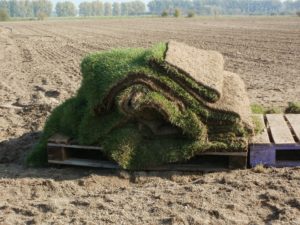
Before buying sod for your lawn, it’s crucial to accurately measure your yard’s square footage.
Before buying sod for your lawn, it’s crucial—albeit not necessarily a thrill ride—to accurately measure your yard’s square footage. This measurement will determine the amount of sod required, so that you can most thoroughly and efficiently calculate costs/quantities of additional materials needed.
Read below as we guide you through the entirely-approachable process of manually measuring your yard’s square footage before a sod purchase.
The Value of Manual Measurements
While digital tools and apps can be convenient (and effective!) for measuring square footage, manual measurements are more advisable in certain situations. If, for instance, your property is irregularly shaped, has sloped regions, multiple landscaped areas that won’t require sod, obstructed aerial views due to mature trees, or if it isn’t accurately represented on digital maps… manual measurements are a must.
Manual Calculations: A Step-by-Step Guide
- 1. Prepare the Tools: Gather the necessary tools for the job, including a measuring tape or walking measuring wheel, a pencil, and paper to record measurements. Alternatively, digital measuring tools or smartphone apps can be used. Remember to be thorough and repeat measurements at least once to ensure accuracy.
- 2. Divide Your Yard into Sections: Create a rough sketch of your yard and divide it into rectangular or square sections. Assign each section a number to keep track of measurements. Dividing your lawn into sections is especially important if you have garden beds, trees, water fixtures, ponds, sheds, or areas that won’t require sod. This helps achieve precise square footage measurements.
- 3. Measure Length and Width: Using the measuring tape, measure the length and width of each section. Start from one corner and measure to the next, along the side of the section rather than the diagonal. Record the length measurement, then measure from the other corner to the opposite side and record the width measurement. Repeat this process for all sections.
- 4. Calculate Section Areas: To calculate the area of each section, multiply the length by the width. For example, if a section measures 10 feet long and 8 feet wide, the area would be 10 x 8 = 80 square feet. [-Okay, take a moment here to let your brain recharge…] Note the area measurement next to the corresponding section number.
- 5. Determine Total Square Footage: Sum up the areas of all sections to obtain the total square footage of your yard. …Nicely done!
- 6. Add a Margin of Error: Including a margin of error of approximately 10% is advisable to account for potential measurement mistakes. Additionally, order a little extra sod to accommodate irregular shapes or corners in your yard.
- 7. Place That Perfect Sod Order, Pal!: Once you have the total square footage, you can proceed to order your sod with nary a hint of trepidation. -Sod is typically sold per square foot, so multiply the total square footage by the cost per square foot to determine the total cost. Of course, it’s never a bad idea to seek advice from your local sod supplier regarding the recommended amount and type of sod necessary prior to purchase.
Closing Thoughts
Measuring your yard accurately is a foolproof way to wind up with a just-right quantity of sod for your lawn-scape project—no wasteful leftovers, no maddening bare patches. By following these manual measurement steps, you can easily determine the exact square footage of your yard, properly perform all calculations, and make an informed decision.
As long as you remember to measure precisely—and -what the heck: twicely!—we have the utmost confidence that everything will turn out… very nicely.
Get Your Yard Ready for Spring
Order early and order often to ensure the best service possible. Contact us through our online page. Please find us at 27616 Little Lane, Salisbury, Maryland 21801. Our phone number is 410-726-6103, and our fax number is 410-742-6550. Speak to Jason Anderson for Turf Grass Sales. Reach him by email at jason@quanticocreeksod.com. Finally, follow us on social media on Facebook, LinkedIn, and our blog!
